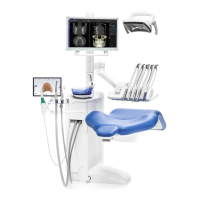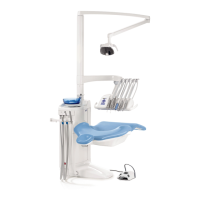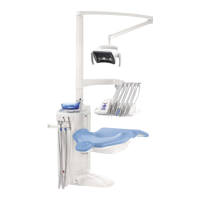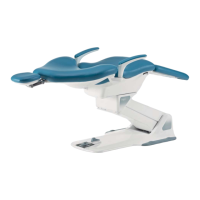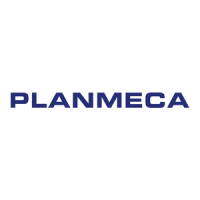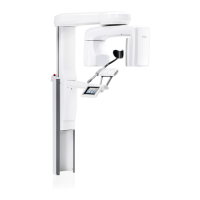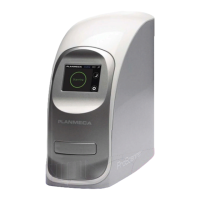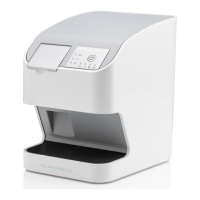Do you have a question about the Planmeca Compact i3 and is the answer not in the manual?
| Brand | Planmeca |
|---|---|
| Model | Compact i3 |
| Category | Dental equipment |
| Language | English |
Lists general safety warnings and cautions for operating the dental unit.
Details safety switches that stop motorized chair movements due to obstructions.
Describes how to quickly halt any patient chair movement.
Provides a visual overview of the dental unit's main components and their labels.
Identifies components that can be detached from the dental unit for maintenance or cleaning.
Defines parts of the unit that come into contact with the patient during treatment.
Describes the monitor's adjustability and the tablet holder's attachment method.
Explains the use of USB ports for connecting external devices like cameras.
Details the connection and status indicators for Planmeca Romexis software.
Describes how to connect and use the Planmeca intraoral scanner with the unit.
Describes the OP delivery arm and its positioning capabilities.
Details instrument consoles with balanced and hanging-tube instruments.
Explains how to connect and disconnect instrument hoses using quick connectors.
Covers instrument spray, chip blow, light, speed limits, and torque settings.
Describes the different types of tray tables available for instrument consoles.
Provides instructions for setting up and using the sterile water system.
Describes the mounting and placement of suction handpieces in the Flexy-holder.
Details the procedure for detaching and reattaching suction tubes for cleaning or replacement.
Explains patient recognition and the Trendelenburg chair position.
Describes how to move, lock, remove, and replace armrests, including surgical options.
Details adjusting the headrest's height, angle, and repositioning for different patient types.
Describes the main control panel's buttons, display, and functions.
Explains using the control panel as a touchpad and mouse for navigation and input.
Details the control panel located on the Flexy-holder for unit and chair functions.
Compares the functionality of standard and wide foot control pedals.
Details the functions assigned to center knob, side knobs, and pedals for various operations.
Describes signing in using PlanID cards or by selecting a user profile.
Explains how to properly sign out of the dental unit session.
Guides on adding new users and removing existing user profiles from the system.
Details how to modify user-specific settings like name, language, and theme.
Explains how to change the user's first name, last name, and the unit's display language.
Describes how to select a colour theme and configure user preferences.
Explains how to restore personal settings to their factory default values.
Provides access to unit type, serial number, software version, and service information.
Details service contact, maintenance, diagnostics, and registration information.
Covers unit IP addresses, network settings, and Bluetooth configuration.
Explains how to view message logs and manage Bluetooth connections.
Describes how to swivel the chair and perform manual adjustments to its position.
Explains how to use and program automatic chair positions for efficiency.
Details selecting predefined chair positions via control panel or foot control.
Describes how to activate the chair's entry and exit positions.
Explains methods to stop chair movements using safety switches or controls.
Covers changing the unit's display language and using the built-in timer feature.
Details operation, indicators, intensity, and colour temperature of the operating light.
Explains the meaning of different indicator light colors on the operating light.
Describes manual and hands-free methods to control the operating light and composite mode.
Explains how to adjust light intensity and color temperature for optimal treatment.
Guides on using the Solanna Vision camera, including activation and settings.
Details selecting cameras, zoom levels, video resolution, and frame rates.
Explains how to start, stop, pause, and record video streams from the camera.
Describes the process of capturing still images using the intraoral camera.
Explains how to use the control panel display for viewing X-ray films.
Explains the unit's instrument logic, including active instrument identification and handpiece exchange.
Details micromotor speed, power, reverse rotation, limits, and spray functions.
Covers torque limits, RPM limits, and conversion tables for the Bien-Air MCX micromotor.
Explains how to use and modify presets for the Bien-Air MX2 micromotor.
Details torque, RPM, apical action, and presets for the Morita TORX micromotor.
Lists factory presets and explains how to modify them for the Morita TORX micromotor.
Guides on using, testing, and interpreting the apex locator for root canal measurement.
Covers turbine speed, power, quickstart, spray, chip blow, and instrument light.
Details scaler speed, power, spray, and specific scaler types like Satelec and LM.
Explains the modes (periodontics, endodontics, scaling) for the Satelec Newtron scaler.
Describes the modes available for LM and EMS No Pain scalers.
Details the operation, programming, and modes of the polymerisation light.
Explains camera connection, operation, image saving, and Romexis integration.
Details connecting, activating, and operating the intraoral camera from the console.
Describes connecting and operating the intraoral camera when placed in the suction holder.
Guides on operating the intraoral scanner using the foot control and software.
Explains the automatic start/stop and manual control of saliva and high-volume suction.
Describes how the tilting mechanism of high-volume suction starts suction and how to temporarily stop it.
Explains how to customize the swipe menu on the control panel by adding, moving, or removing items.
Guides on saving and adjusting automatic chair positions in extended and traditional views.
Details programming instrument spray, chip blow, light, and micromotor settings.
Explains how to set speed/power limits for instruments like turbines and micromotors.
Covers programming instrument spray settings and enabling/disabling sterile water mode.
Details how to program automatic chip blow and instrument light intensity.
Provides programming instructions for Bien-Air MCX, MX2, and Morita TORX micromotors.
Guides on customizing presets for the Bien-Air MX2 micromotor, including saving changes.
Explains how to modify presets for the Morita TORX micromotor, covering RPM, torque, and rotation settings.
Details how to program the duration of the polymerisation cycle.
Explains how to program up to six timer settings into the timer memory.
Covers programming light intensity, colour temperature, and gesture sensor settings.
Guides on adjusting operating light intensity and composite mode settings via the control panel.
Details how to set the light tone (warm, neutral, cool) and maximum brightness.
Explains how to enable/disable the gesture sensor and adjust its detection distance.
Covers programming the duration for door open and assistant call functions.
Explains how to set the dental unit's clock and date, including format options.
Details how to adjust durations for flushing and suction cleaning maintenance programs.
Outlines the schedule for cleaning programs and necessary preparations before starting.
Provides step-by-step instructions for performing short instrument flushing.
Details the process for performing long instrument flushing for thorough cleaning.
Explains how to clean the suction system manually using a disinfectant solution.
Provides a table detailing when and how to clean various dental unit surfaces.
Covers cleaning instruments, the instrument console, and its oil collector.
Details the cleaning procedures for suction handpieces, holders, and tubes.
Explains the weekly process for cleaning waterlines using approved disinfectants.
Describes the steps for cleaning waterlines at the end of the working day.
Outlines the procedure for cleaning waterlines each morning.
Explains the three types of messages: notifications, help, and error messages.
Lists common help messages, their meanings, and recommended actions or explanations.
Categorizes and lists error codes, their meanings, and troubleshooting steps.
Lists common error codes related to valves, circuits, and general unit operation.
Details error codes related to voltage issues, fuse failures, and power supply components.
Lists error codes pertaining to the control panel's display, buttons, and software.
Covers error codes related to instruments, including polymerisation lights and motors.
Lists error codes for the instrument multiplexer, related to signal errors and connections.
Details error codes related to suction holder detection and functionality.
Lists error codes concerning the foot control's cables, buttons, and wireless connection.
Covers error codes related to the operating light's connection, software, and bulb.
Details error codes for the separator system and water management system.
Lists error codes related to patient chair motors, potentiometers, and cables.
Covers error codes related to the main CPU, software corruption, and memory issues.
Details error codes related to the motorized headrest's position, motors, and software.
Lists error codes indicating water leaks and related valve issues.
Covers errors related to overdue yearly maintenance.
Lists error codes that occur during software upgrade processes.
Details error codes specifically generated by the control panel.
Explains how to access and filter the log of help and error messages.
Lists order numbers and materials for various suction handpieces and tips.
Details consumables for sterile water and infection control, including hygiene membranes.
Lists available disinfectants, their order numbers, and contents for unit cleaning.
Provides detailed specifications including manufacturer, dimensions, weight, and environmental conditions.
Lists instruments and their electrical classifications (Type B or BF).
Details physical dimensions, positioning guidelines, and patient area definition.
Illustrates recommended positioning for patient, dentist, and assistant during treatment.
Defines the patient area and specifies allowed devices within it.
Provides dimensional drawings for the over-the-patient delivery system with balanced arms.
Specifies the flow rates for syringes and handpieces used by the dental unit.
States compliance with EU directives for radio equipment and RFID readers.
Outlines FCC Class B and Industry Canada compliance statements for RFID readers.
Provides information on RF exposure limits and required separation distances.
